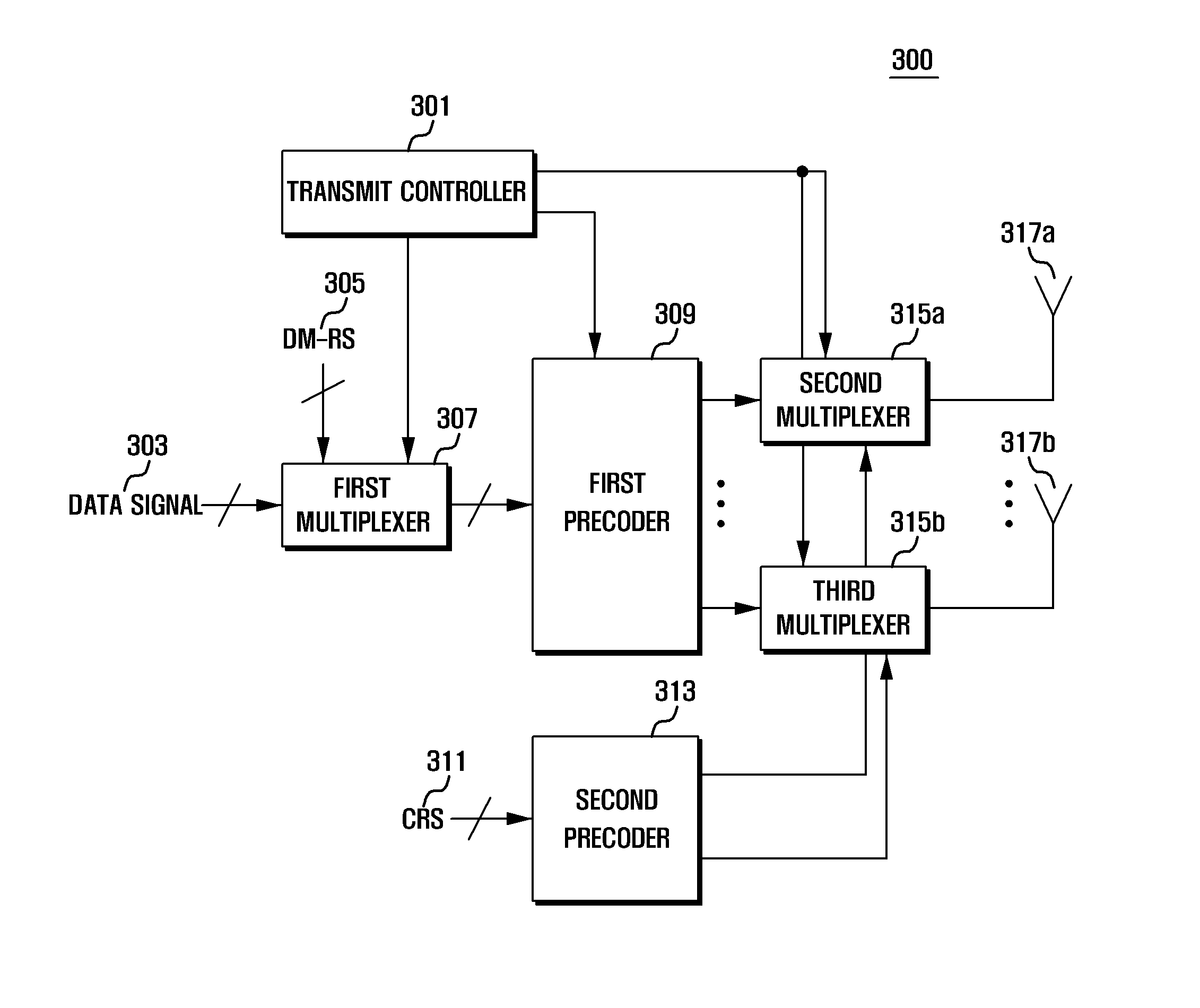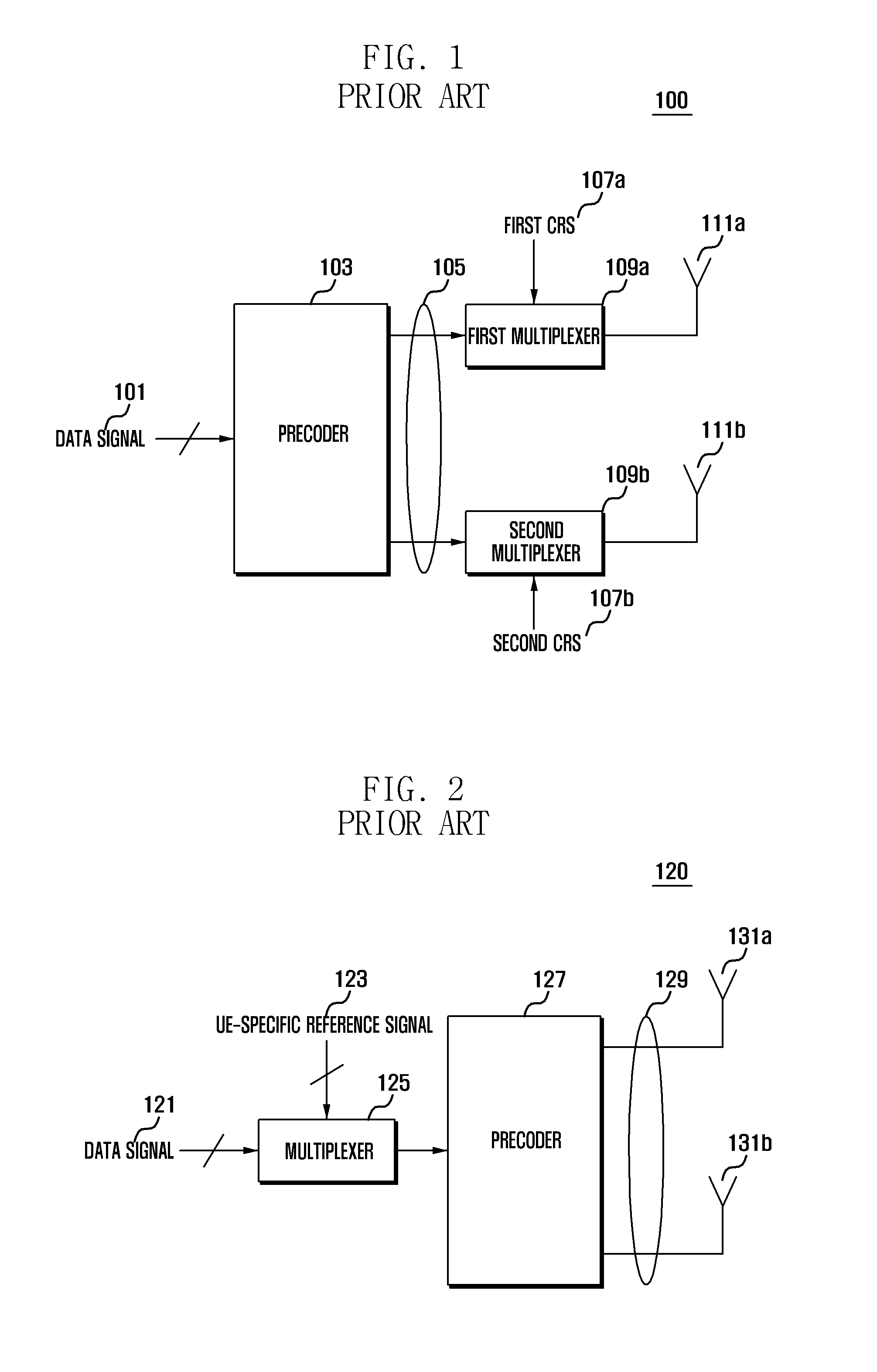Method and apparatus for transmitting/receiving a reference signal in a wireless communication system
- Summary
- Abstract
- Description
- Claims
- Application Information
AI Technical Summary
Benefits of technology
Problems solved by technology
Method used
Image
Examples
first embodiment
[0069]FIG. 8 is a flowchart illustrating a reference signal processing method for a receiver according to the present invention. In this embodiment, the status Information Element, e.g. ‘AntennaInfoDedicated’, includes a mode Information Element, e.g. ‘reuseRel8™’. In this embodiment, ‘transmissionMode’ and ‘reuseRel8™’ can be defined as the mode Information Element in ‘AntennaInfoDedicated’. If the mode Information Element is set (reuseRel8™=set), this means that the common transmission mode is used in the normal subframe.
[0070]Referring to FIG. 8, the receive controller 401 checks the mode Information Element of the higher layer signaling in step 501. That is, the receive controller 401 checks the status Information Element of the higher layer signaling, e.g. the mode Information Element of ‘AntennaInfoDedicated’. Next, the receive controller 401 determines whether the mode Information Element is set to common transmission mode in step 503. That is, the receive controller 401 dete...
second embodiment
[0075]FIG. 9 is a flowchart illustrating a reference signal processing method for a receiver according to the present invention. When multiple dedicated transmission modes are available in the downlink of the LTE-A system, the method according to this embodiment can be applied. In this embodiment, the status Information Element, e.g. ‘AntennaInfoDedicate’, includes a mode Information Element, e.g. ‘rel8Transmission Mode’ for indicating the common transmission mode and ‘rel10TransmissionMode’ for indicating the dedicated transmission mode. That is, ‘reuseRel8™’, ‘rel8TransmissionMode, and ‘rel10TransmissionMode’ can be defined as the mode Information Element of ‘AntennaInfoDedicated’ in this embodiment. When it is configured to not use the common transmission mode, ‘rel8TransmissionMode is not configured in AntennaInfoDedicated’.
[0076]Referring to FIG. 9, the receive controller 401 first checks the mode Information Element of the higher layer signaling in step 601. That is, the recei...
third embodiment
[0081]FIG. 10 is a flowchart illustrating a reference signal processing method for a receiver according to the present invention. In this embodiment, a new dedicated transmission mode is provided for the LTE-A system as shown in Table 3. In Table 3, the transmission modes from ‘tm1’ to ‘tm7’ are common transmission modes, and the transmission mode ‘tm8’ is the dedicated transmission mode using the DM-RS. In the new dedicated transmission mode, the transmission diversity scheme is used as the fallback transmission scheme. In this embodiment, the mode Information Element, e.g. the value set to spare1 in ‘transmissionMode’ is replaced by ‘tm8’ rather than newly defining the mode Information Element of ‘AntennaInfoDedicated’, e.g. ‘reuseRel8™’.
TABLE 3FallbackTransmissionTransmissionModeReference Transmission SchemeSchemetm1Single antenna Tx; antenna port 0Transmissiontm2Transmission DiversityDiversitytm3Open-loop Spatial Multiplexingtm4Closed-loop Spatial Multiplexingtm5Multiuser MIMOtm...
PUM
 Login to View More
Login to View More Abstract
Description
Claims
Application Information
 Login to View More
Login to View More - R&D
- Intellectual Property
- Life Sciences
- Materials
- Tech Scout
- Unparalleled Data Quality
- Higher Quality Content
- 60% Fewer Hallucinations
Browse by: Latest US Patents, China's latest patents, Technical Efficacy Thesaurus, Application Domain, Technology Topic, Popular Technical Reports.
© 2025 PatSnap. All rights reserved.Legal|Privacy policy|Modern Slavery Act Transparency Statement|Sitemap|About US| Contact US: help@patsnap.com



